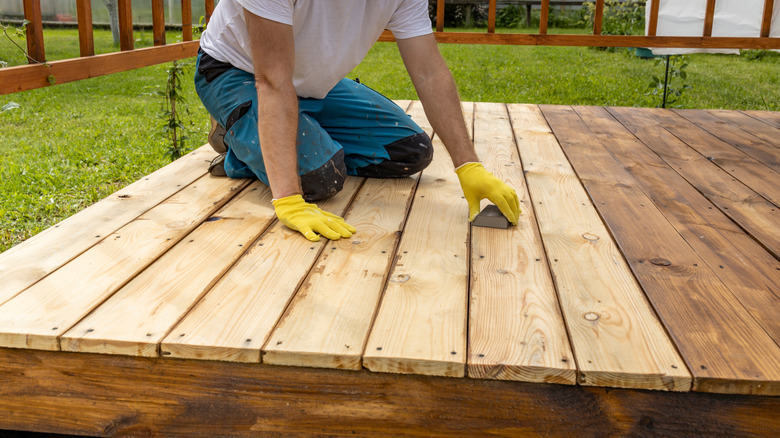DIY A Floating Wood Deck That Is Perfect For Grilling
We may receive a commission on purchases made from links.
Summer is calling, and it's time to whip out the grill and an apron. But why settle for soggy grass or cracked concrete when you could be grilling on your very own homemade floating patio deck? This DIY project combines contemporary style, function, and let's be honest, bragging rights, to seriously upgrade your backyard area. Surprisingly, it's not extremely complicated. You'll start by creating a wood-framed foundation to lay over five deck concrete blocks for support, before adding top planks to complete the build.
This trendy patio design idea also features a cute wood-based privacy screen to conveniently use as a storage location for grilling utensils. A project like this requires attention to detail regarding measurements. Though it's not the most complex deck, it's definitely not one that can be built in an hour or two. The most expensive purchase for this project will likely be the wood planks, and the type of wood you use will dictate the cost.
Expect to pay anywhere from $8 to $13 for a typical 6x12-inch pressure-treated patio plank, and about double that for composite deck boards. The five concrete blocks used for the corners and the middle generally cost about $10 each, and they should be supported with gravel or sand, which can range from $4 to $6 per bag. And don't forget about your building tools, such as a DeWALT power drill, fasteners, a tape measure, and an electrical saw. Note that you can also have Home Depot or Lowe's cut the planks for you.
Steps to create your own wooden floating deck
Before tackling this project, you should be prepared to transport the concrete blocks, which weigh about 40 pounds each. Combine this with the wood planks and bags of gravel or sand, and you've got quite a back-breaking task. Having a wagon or extra set of hands on deck (no pun intended) can help this project move along more easily and faster.
Before revamping your space with this outdoor patio idea, measure your backyard to determine the best deck size for the area. One of the most crucial aspects of the build is creating a solid foundation, both with the concrete blocks and the wooden frame. After this step, it's simply a matter of covering your frame and ensuring that everything is sturdy.
You can cut down on the frame's drilling time by opting for composite-based planks with interlocking features. Start by preparing space for the patio by digging holes for each concrete block. Then, pour gravel inside them before placing each block on top until about 4 to 6 inches stick out of the surface. Next, assemble your wooden patio frame and lay it on top of the blocks. Finish it up by laying down the top planks. Finally, add privacy screen beams and wood panels if desired.
Ways to customize your DIY backyard deck
This deck also works well to spruce up backyards that are limited in space. You can simply copy the build, but on a smaller scale. For example, instead of making a floating patio that measures 12x12 feet, consider one that measures 8x8 feet. Also, if you already have a concrete slab in your backyard, you won't need to go through the hassle of creating the foundation; you can build the planks on top of the slab, using it as a base. However, support boards (aka "sleepers") will still be required, in addition to an anti-moisture barrier to prevent moisture from the slab from seeping up into the panels, causing wood rot.
Want more private grilling sessions? Consider including additional privacy panels to create an intimate outdoor environment, while maintaining easy ventilation. And why not jazz it up with a little color? Experiment with colored latex paint and hanging string lights to give your patio a festive vibe. Maybe install an awning and toss in a Best Choice Outdoor Recliner for added comfort. Go even further and couple it with a LIFFY Patio Side Table for those summer nights when you want to relax outside.
Make this floating deck your own by adding interesting touches to the surrounding area, such as gravel, a bed of flowers, or plants. This will also be more involved, but it can make for an exquisite, attention-getting space. Adding glow-in-the-dark stones or painting the pavers around the deck can also help stylize it and give it an edge.

